Telecoms are using a mixed bag of frequencies and calling it “5G.”
To simplify things, let’s borrow the ice cream analogy used by Brian X. Chen in his January, 2020 New York Times article on 5G.

Rocky Road
This is the 5G flavour that is generating all the hype, the one that promises us autonomous cars, artificial intelligence and virtual reality.
Rocky Road uses high frequency millimetre waves in the 25,000 to 39,000 MHz band, which are able to transmit data at theoretical maximum speeds of 10,000 Mbps.That is 100 times faster than the 4G cellular networks we currently have.
These millimetre waves must be “beam formed” and only transmit when called upon by a 5G-enabled device. This beam is narrow, and does not sweep a neighbourhood with full force. It transmits on demand and only to the house where the 5G-enabled device is located.
Rocky Road sounds promising for those who want an Internet of Things, and don’t mind being irradiated in the process. But there is a hitch.
Millimetre wave signals don’t travel far and are easily blocked by walls, trees and windows – even rain. In real-life trials, Rocky Road only seems to work when you are right beside a transmitter. Which might cause something to melt.
To sum it up, because of its limitations, Rocky Road will unlikely be available for general consumption.
Vanilla
This is the variety of 5G that uses low and mid band frequencies and some beam forming. Although telecoms say Vanilla 5G is 20-50% faster than the best 4G speed now available, other than less lag time (called latency). in real life trials users are barely noticing a difference between Vanilla and current 4G.
In Canada, the low-band frequency being used for 5G is in the 600 to 700 MHz range. The mid-band frequency dedicated to 5G is in the 2500 to 3700 MHz band.
Dairy-Free
This form of 5G uses low-band frequencies in the 600 to 700 MHz range only, with no beam-forming. Timothy Schoechle, author of Reinventing Wires refers to it as “4G labelled as 5G for marketing purposes.” Calling it ice cream would be false advertising.
The danger with this variety, however, is that unlike Vanilla and Rocky Road, which work on demand and send signals directly to 5G-enabled devices, Dairy-Free, like 4G LTE, is always on. This means if a microcell transmitting Dairy-Free is placed by your home, you will be constantly bathed in high levels of radiofrequency radiation. .



The Flavour Big Telecom Doesn’t Want us to Know About
Recent developments in fiber optics technology, have sent data at speeds of 200,000 Mbps, 20 times faster than the speeds promised by high frequency Rocky Road 5G. And without its serious biological effects. We all know the benefits of eating a high fiber diet. Hands down, Fiber Wired to the Premises is by far the healthiest and most delicious option.
Learn more about the technical aspects of 5G in the “Tech Talk” section on page 3 of the Primer found HERE.
Load More
5G is being marketed as a “game-changer” – as the gateway to a bright new future of possibility and innovation.
The truth? Wired fiber optics can bring the benefits 5G promises faster and more reliably.
Here’s the Hype about 5G:
Share crystal-clear live video even from a sold-out stadium.
- Why distract yourself by live-streaming an event? If you feel compelled to share things over a Smart Phone, use 4G to stream a few minutes worth. That is all most social media viewers will watch anyway.
Visit your doctor without leaving home, with life-like virtual visits and remote care.
- Using a secure, reliable fiber connection is the smart way to share personal medical information over the Internet. A mobile connection would be a last resort.
Stress less with Smart City breakthroughs, from reduced traffic to safer neighborhoods.
- The basic backbone of a smart city is fiber. Wireless is for the few things that can not be wired and are really needed.
Load apps and sites faster than you can blink with potentially up to 20X faster download speeds.
- Fiber is up to 20X faster than wireless 5G with symmetrical upload and download speeds. This means you can create and share content as easily as you can consume it.
Get emergency help quicker, with first responders sharing vital information essentially in real-time.
- A wired fiber connection is always the fastest, most secure way to connect. If you need mobile, 3G or 4G is enough. 5G adds little or nothing. If most people move to fiber access for the majority of their usage, then 3G or 4G will perform better when you actually need wireless access.
5G will help enable transformative mobile services like self-driving cars and interactive distance learning.
- Wireless is too unreliable and unpredictable for anything safety-related such as automatic driving functions. For non-vital functions, wireless devices are a driver-distraction. Remote learning is tough enough without trying to do it on a mobile device. Fiber wired directly to the premise is the answer.
Load More
Load More
The short answer is No. In this letter, Telecommunication engineer and Information Technology architect Miguel Coma explains why.
Load More
Ask the party making this claim to provide proof of the conspiracy.
This proof must include non-industry funded science that shows that 5G will reduce energy usage and not contribute to climate change, that 5G poses no threat to data privacy and security and raises no liability issues, and that the millimetre waves 5G will employ cause no adverse effects on people, flora and fauna.
Load More
Yes.
Policymakers worldwide are issuing resolutions placing a moratorium on 5G or calling for research before its deployment. To learn where 5G has been halted or delayed, click here and here.
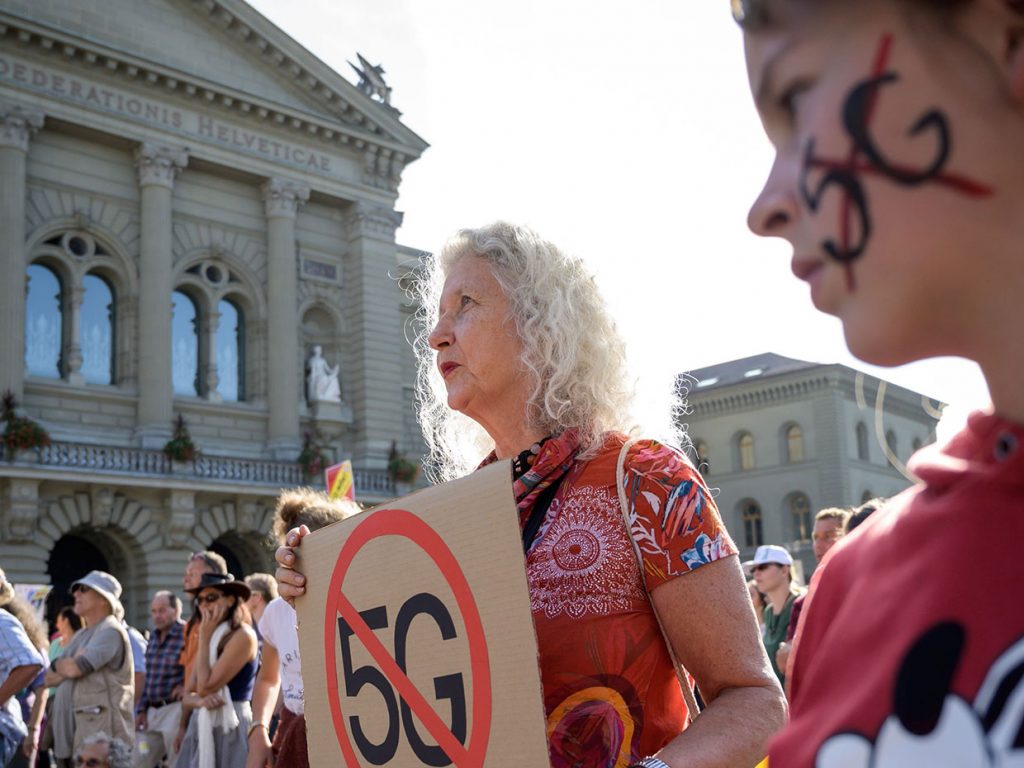


Load More
On a home modem or router, “5G” stands for “5GHz” — and it’s one of the two frequency bands routers can use to broadcast WiFi through your home. You might see it as an option next to 2.4 GHz. This is not 5G cellular.
Load More
A”Microcell” is a low-powered cellular radio access node that has a range of 10 meters to a few kilometres and is used to increase a cellular network’s capacity.
“Microcell” is the name industry and government in Canada initially used for what is called a “Small Cell” in the United States. Recently, Canada has adopted the term “Small Cell” but alas – this site and its acronym had already been born! Technically “Small Cell” is the umbrella term for femtocells, microcells and picocells.
The term “Small Cell” is regularly misused, even by industry. Accurately speaking, a cell is not an antenna, but the effective area/range of an antenna’s radiation. Telecoms plan to install hundreds of thousands of microcells, often several to a block, to transmit the millimetre wave high frequencies of 5G. Millimetre waves have a short range and don’t propagate well, which is why industry needs to install a lot of small cells for 5G to “work.”
5G will not replace 3G and 4G, but will join them. Because 5G is a mix of frequencies, 5G antennas are also being placed on macrocells (“Large Cell” towers) to transmit low to mid band 5G. Despite what we are told, when it comes to antennas and transmitters, distance is not our friend. The farther the source, the greater the reflection and refraction of signals. The physics of artificial electromagnetic radiation show that any antennas is too close. Exposing all living thing to toxic wireless technology is damaging our ecosystems and causing serious biological harm.
A Verizon 5G Data Box arrives without notice on a Houston lawn, 2021:
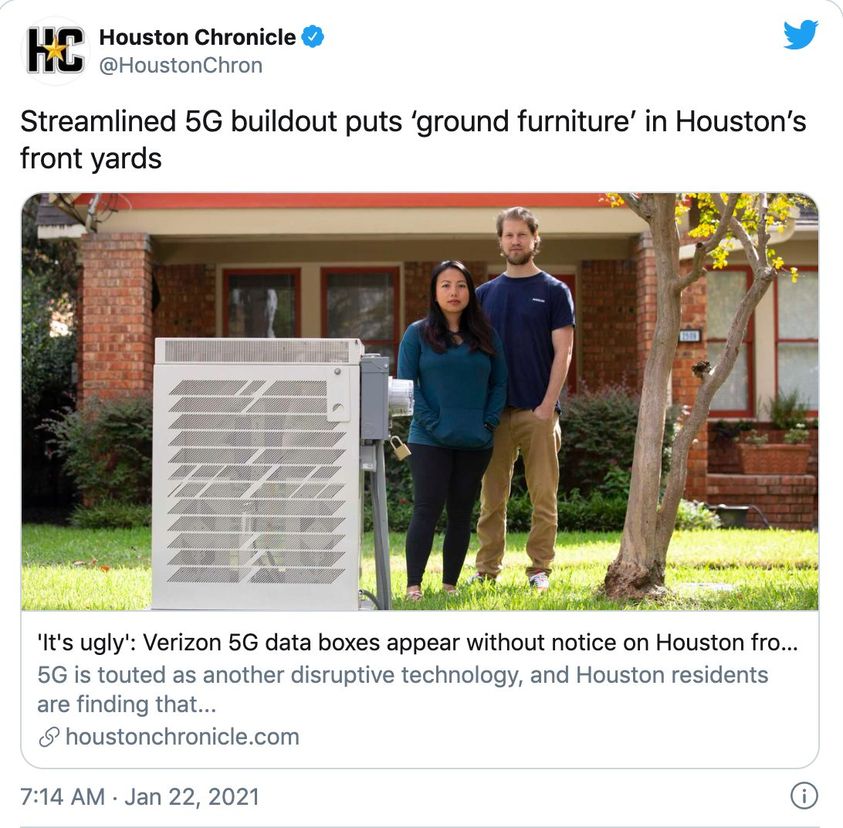


Load More
Big tech has big plans, including 5G, smart cities, and the Internet of Things (IoT).
5G and microcells are not about bringing broadband to underserved communities or filling existing coverage gaps. They are about data control, marketing, and money. They represent an era when technology no longer serves us, but shapes us. At a presentation he gave to The Institute of Electrical and Electronics Engineers (IEEE) in December 2016, respected industry expert Dr. H. Anthony Chan, a Senior Researcher with China’s Huawei Technologies, was asked about the basic motivation driving 5G. His response: “…if technology does not change, the company will die…it is about more jobs…engineering and manufacturing.” Chan added, “people must buy a new phone.”
Put simply, we are told 5G is about progress, but it is about profit. It will add to the harmful toxic burden created by existing 3G, 4G and wireless technologies. It also gives governments a handy tool for surveillance and control.
Load More
The Deck is Stacked …
A look at reported lobbyist communications from February 2020 to February 2021 between Canada’s big telecom companies and government officials reveals that big telecom lobbies Ottawa twice a day.
And It’s Complicated …
Telecommunication regulators and industry are now pushing to take away the limited local input we have over the placement of small cell antennas in our communities.



Bye Bye Bylaws
Telecommunications fall under federal jurisdiction in Canada, as most municipal leaders are quick to point out. In Canada, unlike in the US, municipal governments are generally prohibited from creating bylaws or ordinances that allow them to regulate anything to do with antennas or telecommunications. Several legal precedents support this and help pave the way for 5G.
In Bell Canada Inc v The City of Calgary, 2018, the Court of Queen’s Bench of Alberta ruled that a bylaw of the City of Calgary regulating the process for access and use of municipal rights-of-way does not apply to telecommunications providers.
In Telus Communications Co. v. City of Toronto (2007), the Ontario Superior Court ruled that the City of Toronto could not enforce a site plan bylaw that was not specific to, but would apply to, new antenna sitings, as this could allow the City to impede Telus’ ability to maintain a functioning network.



There is one uncontested Canadian legal precedent that challenges the notion of exclusive federal jurisdiction over telecommunication undertakings.
In R. v. City of New Westminister (1965) the BC Court of Appeal ruled that a municipal licensing bylaw applied to a federal undertaking. The Court held that the City of New Westminster could refuse to grant a business license to a federally-regulated cable company because the cable company’s federal license did not exclude it from being bound by provincial laws and municipal regulations concerning business operations.
Based on the Canadian Court’s interpretation of Section 43(5) of the Telecommunications Act, two other uncontested legal precedents support communities in denying access, in some instances, to the infrastructure needed for 5G:
1) The first says the CRTC is not authorized to mandate that the fiber or equipment needed for 5G and cell towers be placed on electric utility poles



1. Amend theTelecommunications Act to take away local governments’ and private landowners’ right to refuse antennas on their property, therefore consolidating federal authority over the infrastructure that will support 5G.
2. Create a “Canadian Communications Commission” which will be given the final say in all radiocommunication and telecommunication siting matters and dispute resolutions, and will have the power to override any existing provincial or municipal rights that may impede 5G.
Learn more Here: See Section 5.2 of ISED’s Spectrum Outlook 2018 to 2022: “Antenna Sites and Structures”
Here: See Section 2.4 of the January 2020 Report from the Broadcasting and Telecommunications Legislative Review Panel “Unlocking the advanced networks of tomorrow”
And Here: See CRTC wants more power over 5G infrastructure placement, chairman tells Senate
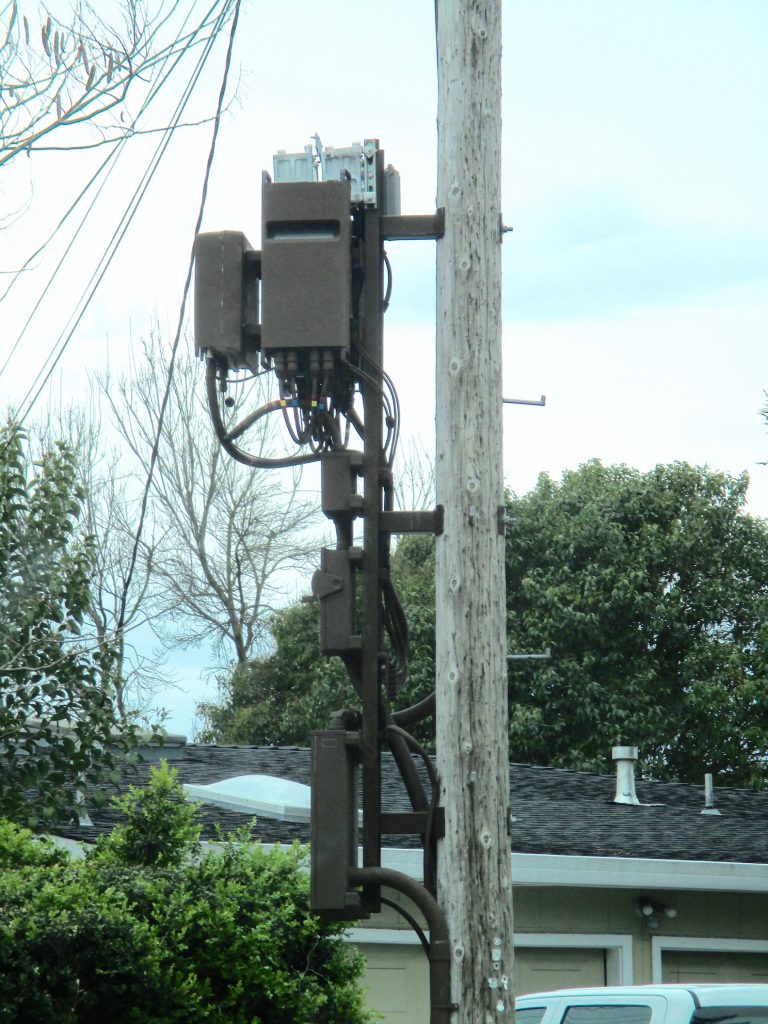


Who has the Power to Place Small Cells by our Homes?
At the Federal Level:
Innovation, Science, and Economic Development Canada (ISED) has the final say over microcell placement in Canada. Their rules allow microcells to be placed on existing structures by our homes without any public consultation. Installations may also be placed on existing towers without seeking local government consent.
ISED does not currently have the right to force public or private landowners to allow small cell antennas on their property.
At the Local Level:
Telecoms are required to notify whoever owns the street you live on – either your local government or the provincial government – when they want to install a microcell there. They must provide government officials with some details of their plans.
If the proposal meets all local requirements, then your municipal government is required to agree to the plan, and it’s a done deal. At that point, site permits giving the telecom authorization to install the microcell on your street will be signed. If the microcell will be attached to a utility pole, street lamp or other structure, permission must also be obtained from whoever owns that. Both the owner(s) of the right-of-way and the structure usually charge an annual fee to the telecom for each microcell installed.
Note: Pole-leasing and blanket permitting agreements between the owner(s) of the public rights-of-way, the utility poles or lampposts, and telecommunications providers may already be in place before microcell applications are submitted. Contact whoever is in charge of antenna applications where you live to find out what agreements exist, permits are in process, and antenna siting policies are in place.
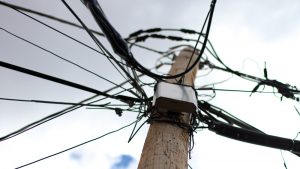


How Local Governments May Protect Their Citizens
Learn from the Best HERE are some examples of what other Local Leaders are doing about this issue.
Establish the Game Rules Creating an Antenna Siting Protocol that includes small cell antennas gives your local government some leverage in the siting of microcells. Use this handy guide and create antenna protocols that are as protective as possible.
Create More Protective Radiation Exposure Standards The federal government says all antennas must conform to Canada’s inadequate radiation exposure guideline Safety Code 6, but Provincial law charges local governments with protecting residents’ health. Local governments may establish their own, more protective standards, adding an additional layer of regulation on top of federal guidelines and may integrate these standards into Antenna Siting Protocols. Antennas installed on both Salt Spring Island, BC and in Toronto are asked to conform to standards that are 60-75 times more protective than Heath Canada’s guidelines.
Ask for What You Need This document shows how the Town Council of Western Springs, Illinois responded to a small cell siting application made by Crown Castle. As a result, the telecom withdrew its application.
The Right to Refuse? If a proposed microcell installation does not comply with a local government’s requirements, as laid out in its Antenna Siting Protocol, a municipality may issue a letter of non-concurrence to ISED, refusing the antenna. There is no precedent for how ISED would react if a local government refused all proposed microcell installations, but policy decisions to date weigh heavily in telecoms’ favour. If a carrier cannot reach what they consider to be an acceptable agreement with a local government, then the CRTC and/or ISED can enforce its own conditions upon a municipality.
Private & Public Property If a telecom wants to place a microcell on private property, like a church, whoever owns that property must give their signed permission before the antenna may be installed, usually for a fee. If the microcell is to be placed on public property, even if it is not on an existing structure, municipal governments may choose to forgo a public consultation process. Local governments are required, however, to notify nearby residents before antennas are installed on public property.
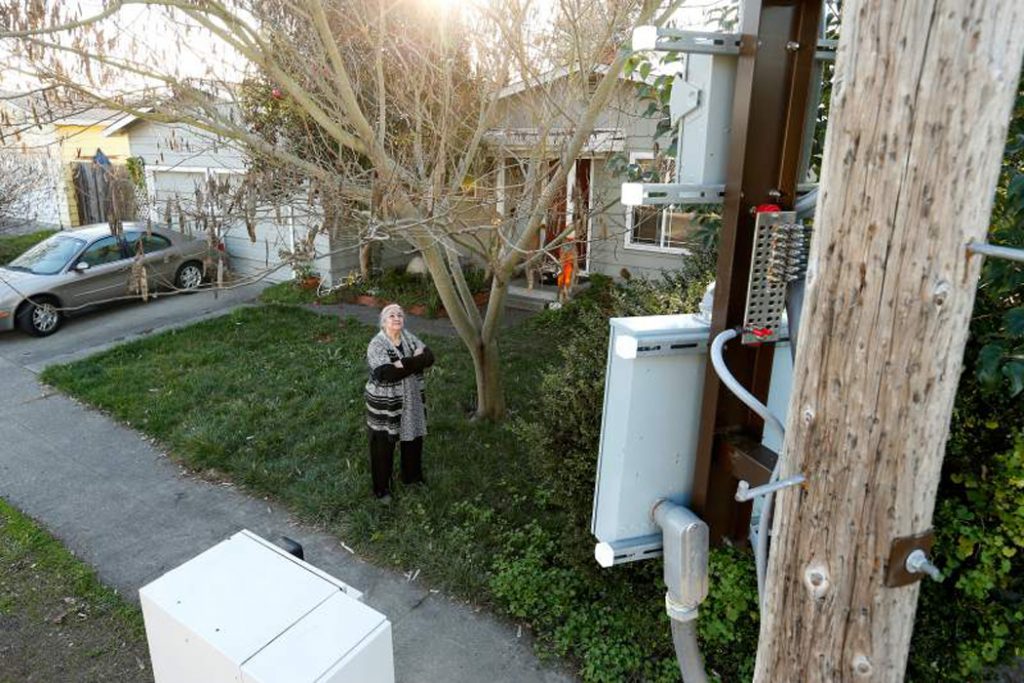


Verify with your local land use authority that they have given permission for that microcell to be installed.
If the microcell is “legal”, its removal depends on changes being made to federal telecommunications policy and perspective.
To facilitate policy change, educate yourself and others – including friends, family, neighbours, co-workers, health practitioners, educators, union reps, environmentalists, the media, and elected representatives – on the health, environmental, privacy, property value and public safety aspects of this issue. Share this site. Work together to create a “new normal” – one rooted in safe and healthy high-speed connectivity.
Load More
The majority of industry-funded studies do not find health effects caused by wireless radiation. But the majority of independent studies do. Anyone studying the research must be careful to “follow the money trail.” Learn about this HERE.
The adverse biological effects of wireless technologies, including DNA breaks, the increase of free radicals, the opening of the blood brain barrier, and cancer are documented in high profile studies like the:
- The Ramazzini Institute cell phone study
- The 7-nation European REFLEX study
- The 13-country Interphone Study
- The $30 million, 10-year U.S. National Toxicology Program’s Study on 2G and 3G Radiofrequency Radiation
Oftentimes, such findings are followed with an attempt to discredit the scientists involved. However, other scientists later confirm the findings.
While not all authorities say there are health effects from wireless technologies, an increasing number of government health organizations are calling for precautionary measures in light of growing scientific concern. This is remarkable given the conflict of interest in research on wireless and health.
Load More
Wireless networks are easier to hack than wired ones are, which threatens our national and personal security. The controversy over using components made by Chinese tech giant Huawei in our 5G network shows the vulnerability of these systems. Whoever owns the equipment controls the data.
5G ushers in a new age of surveillance capitalism. And as Big Tech pushes us towards a world where everything is wireless, corporations are planning on selling our personal data and consumption patterns, putting an end to privacy as we know it.
Load More
The Canadian Radio and Television Commission (CRTC) has declared high-speed broadband internet an essential service. But giving telecoms carte blanche to fulfill this mandate creates a conflict of interest.
In the name of faster Internet, hundreds of thousands of 5G satellites are being launched into our skies, interfering with weather detection at a time of climate crisis, and denying astronomers and every living thing on Earth a dark night sky.
Built-in obsolesce, competition for subscribers, and data mining for profit and control are just a few of the reasons commercially-owned wireless networks don’t support the public good. The alternative? Recent breakthroughs in fiber optic technology make it the best, and fastest option for bringing high speed internet to Canada’s remote communities. Want to truly rethink the Internet? Think about locally owned and wired fiber-optic based broadband networks instead of wireless 5G.
Load More
Yes we can.
Due to a recent technological breakthrough, fiber optics can now transmit data at 200 gigabits per second – about 20 times faster than the theoretical speeds promised by the fastest versions of wireless 5G Forget 5G satellites. Forget beaming signals through wireless transmitters. This breakthrough defines fiber as the solution for rural broadband and all of our internet needs.
80% of wireless traffic is generated indoors. We do not need microcells placed by our homes to provide cell service for the 20% of time our usage is mobile. Fiber-optic cables – which carry signals by pulsing light – are already used to connect microcells to the “hub”. Completing the “last mile” by extending the fiber to every premise would:
- permit the implementation of safe, secure, and truly green wired smart city applications
- allow those who choose to create their own IoT worlds to do so by using the lightening-fast connection supplied by direct fiber with a personal wireless router
- reserve existing cell towers for necessary mobile needs
- save those who choose wellness and safe data over gadgets from being forcibly exposed to microcells
A wireless connection consumes roughly 10 times more energy than a wired one does. However, given the glut of resources used to manufacture all digital devices, wireless and wired, planned obsolescence, and the energy required to power our devices and store our data, we should be greatly reducing all of our digital consumption.

